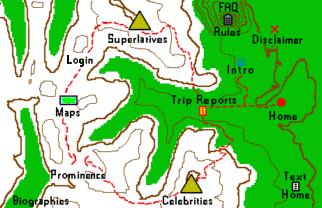|
Class Ratings Definitions
*
|

|
* by John Mitchler
Class Ratings Definitions
Climbing classes should relate to climbing difficulty, not climbing exposure,
although books on the subject always seem to link climbing gear with climbing difficulty.
Difficulty and exposure ought to be analyzed separately when contemplating a route.
I can envision a level wood plank that crosses a 1,000 foot wide chasm that is a
hands-in-pocket Class 1 walk that only an idiot would do without rope.
I can envision a Class 5.11 overhang boulder maneuver that is 3 feet off the ground
with a crash pad underneath for which only an idiot would ask for a belay.
As every individual has a different set of climbing skills, the line between each climbing class is fuzzy,
e.g., a fat man's Class 4 struggle may only be a Class 2 reach to a long-armed young stud.
Given two equal climbers, a fear of heights will change the formula, so that one man's
3 is another man's 5, and the system disintegrates.
I witnessed this phenomenon on Mount Wilson last weekend.
Similarly, a petrifying death walk to my mom is just an enjoyable, airy view to Dave Covill.
So why compound fuzziness by combining two concepts into one?
That being said, I suppose you could correlate exposure with climbing difficulty,
so that if you call me and said, "Let's go do a Class 4 peak.",
I would automatically pack my rope,
but it may be prudent to build each case on it's own distinct merits.
Climbing Classifications Defined by Gear-Needed-for-Exposure
- Class 1 = tennis shoes okay.
- Class 2 = hiking shoes recommended.
- Class 3 = jock strap needed.
- Class 4 = Mr. Rope makes an appearance, if just for morale.
- Class 5.1 = rope me; any type of belay.
- Class 5.3 = rope me; anchor belay.
- Class 5.4 = cams.
- Class 5.6 = chalk.
- Class 5.11 = levitation device helpful.
- Class 5.14 = Holy Bible helpful.
[Note: some studs can do 5.6 with tennis shoes; and some folks need chalk for Class 2+.]
Climbing Classifications Defined by Moves and Maneuvers
- Class 1 = hands-in-pocket.
- Class 2 = hands touch rock for balance.
- Class 3 = hands grab rock for climbing.
- Class 4 = mindful thought needed to coordinate
hands grabbing rock for climbing.
- Class 5.1 = eyes squint slightly and soft "hmmm"
is heard under breath, as contemplation increases.
- Class 5.3 = eyes squint and "hmmm" is heard as contemplation rages.
- Class 5.4 = things like stemming introduced.
- Class 5.6 = monkey moves.
- Class 5.9 = difficult moves often lead to hand grabbing rope.
- Class 5.11 = both hands clutch rope.
- Class 5.14 = both hands clutch crotch.
Edward Earl offers a somewhat more standard set of
class definitions
using a difficulty metric.

